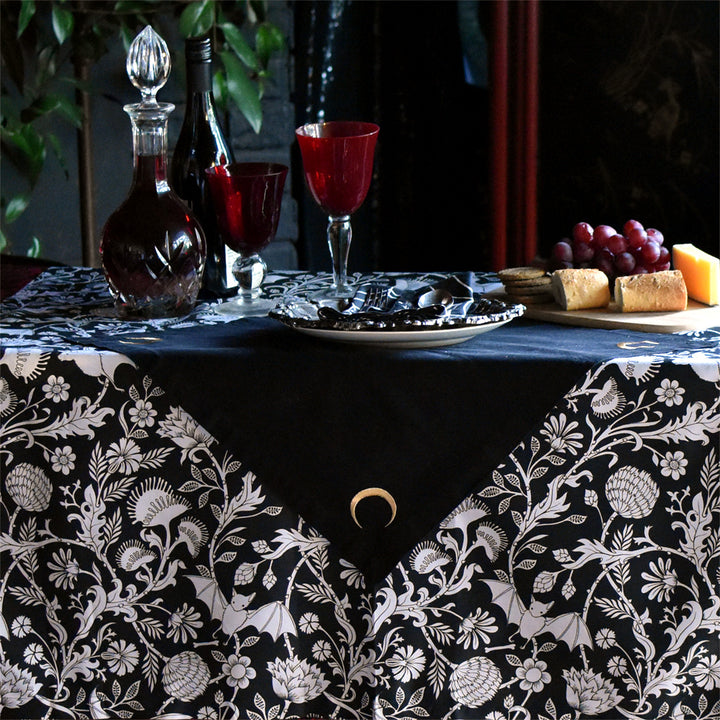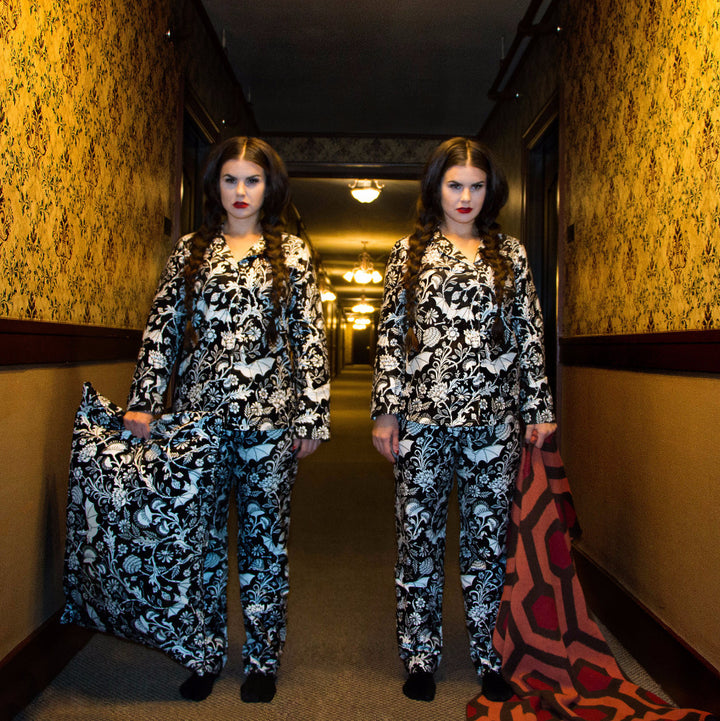Pillow Talk with Kathleen Jennings
Kathleen Jennings, designer of Sin in Linen’s Darker Academia pattern, gets under the sheets with us for some Pillow Talk. Join us for a sneak peek into Jennings’ fascinating creative world.
Kathleen is an award winning published author with a wide variety of talents including pattern design, a massive cabinet of curiosities assembled via her blog, complete with a visual portfolio, and observation journal.
At Sin in Linen, we are very proud to work with a variety of artists for our unique designs and enjoy opportunities to showcase their incredible work. Let’s dive in with Kathleen as she shares the story behind “Darker Academia”, and to see what she’s been getting up to in Brisbane. Her thoughtful, as always, responses are a treat to read. Psst…her collection of short stories, Kindling, is available now!

If Darker Academia was a book, who would its antagonist be?
Ooh… possibly a Count, or the first wife, or an ominous, luminous figure in the library who is in fact a trick perpetrated by the governess (do I run an account dedicated to such Gothic scenarios? I do! @girlfleeshouse on tumblr and X).
I would think that print design is storytelling in its own right. How does your work as an author influence your process?
Surface design is very much storytelling in its own right, and in a different way to — say — book illustration. When people ask if I see writing as different from drawing, I say they are pulled from the same aquifer, through different wells. When I write and when I draw, I am creating a world, wholecloth, out of marks on a surface. And there are skills and techniques that directly and indirectly translate from one to the other. (I write about this and give exercises for writing and illustrating on tanaudel.wordpress.com.)
The all-over design of “Darker Academia” alludes to books, of course, especially Poe’s work. But the images don’t have a text to directly push against, the way illustrations in books do. So I had to think of the design as both containing elements of a story and pulling a part of that story into the world: the sort of place that would have this sort of gothic bedding or curtains. It let me indulge in that descriptive urge very directly, without needing to edit sentences!
Finally, because I write in Gothic modes (and in fairy tales, which are very close neighbours — think of “Bluebeard”!), I love working in this imagery — pulling motifs and the matter of those stories back out into images, in a design that lets the viewer mix and match elements and make up their own stories.
In your opinion, what makes something gothic? How has this definition changed over the years as the term ‘gothic’ has taken on varying meanings in pop-culture?
I could get deep into the academic terminology — I did a degree studying that — but practically, and for illustration purposes, I like to line up a series of Gothic novel covers and pull from that. At the least, a certain degree of potential for a girl to be fleeing an ominous house during a storm seems necessary! There is this whole inherited, accumulated vocabulary of imagery that can instantly create, evoke, invoke a Gothic atmosphere. And under that are these themes of history soaking back up and contaminating the present, of unnatural growth and decay, irrationality and what lies beneath ‘civilisation’.
In my mind, gothic literature evokes images of rainy street corners in London and lush green forests. How does the more temperate environment in Brisbane influence your work?
I live in humid, flooding, overgrown Brisbane now, and grew up in the much drier landscape of Western Queensland. I spent a lot of time imagining the books I read, using the only visual vocabulary I had. So I’m very interested in how to transfer that mythic weight of, say, the archetypal crumbling castle ruin across to the landscape I know. When I wrote my Australian Gothic novella Flyaway, I was trying to capture a parallel to the intense visual beauty of northern and particularly English Gothics — to let the beauty of ironbark and white dust be trustworthy, no matter what other unsettling secrets and mysteries were coming to light. (There’s a tradition of beauty in Australian Gothic literature — think Picnic at Hanging Rock — but it’s often overshadowed by the grotesque.) But the other aspect I encountered was how readily the metaphorical language of the Gothic fairy tale adapted to the landscape — invasive species, things growing out of control, transformation and (mal)adaptation and really unwise bargains…
In Kindling (my short story collection, published this year) I touch on a few other approaches to this. The stories in that which are set in Brisbane or nearby areas are heavily affected by the rich light, the memory of water. My next book (out in 2025) will really lean into that subtropical Brisbane Gothic — the memory and potential return of floods, the creeks and rising steam, the decay and the lushness, and the quality of the light.
With this climate in mind, how do you stay cool in bed during the summers? Any specific fabrics or blanket layering techniques that help you beat the heat?
Ceiling fan, and a pedestal fan with a cross-breeze. I am a doona (duvet/quilt) person — I love the piled-up weight of it! — and so usually I suffer. I have been known to rub the bed down with a freezer block. But now I have solar panels and air-conditioning, the biggest two tricks are to (a) use the dehumidifier option instead of “cool” (more efficient, apparently, and colder), and (b) to set the timer so the air comes on just before I wake up, which stops me waking up cranky.
Picture this: The day is over, and slumber is about to begin. What’s your go-to routine?
I am usually up very late drawing or writing or reading — evening is the best time to work because no-one is likely to interrupt me. So by the time I get into bed, I’m creaky. I stretch out my back on the floor, crawl up the side of the bed like something in an M. R. James ghost story, sink down between the pillows, remember I haven’t finished my observation journal for the day (observation journal), read a chapter or two of an early/mid-century murder mystery if I have one on the go, doze off with the light on, wake myself up by snoring, reanimate and turn the light off, throw the pillows around a bit, then select some favourite story-scenario to start playing in my mind, and usually pass out just as it gets melodramatic.
Your blog is bursting at the seams with all the amazing work you’re doing! Thank you for sharing your incredible insight with the world. What are a few upcoming works that you’re particularly excited about (that we’ll be keeping a close eye on)?
Thank you so much! I love stumbling across blogs dense with thoughts and exercises and images, and hope mine can be that for other people.
It’s difficult to hint too much at art before it is announced! There will be another fantasy book map released before too much longer, I hope, and a cover for a collection of speculative stories for a magazine, and some very lighthearted endpapers for another book. And every month I put up a printable calendar.
My short story collection Kindling is officially out in Australia this June ( it was published in the USA in January). It contains a few Gothic-adjacent tales, especially “Undine Love”, related to Flyaway, and the very sunlit-Gothic “Not To Be Taken”, which has a lot of poison bottles in it. I’m thrilled to have it out in the world.
I am hoping there will be a follow-up to my chapbook Travelogues soon, as well. Travelogues is a written sketchbook of scenes from railway journeys, sounding out descriptions with words the way I’d feel for them with a brush, and I’ll announce the sequel when I can!







































Leave a comment